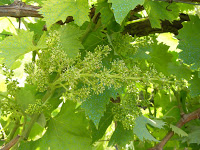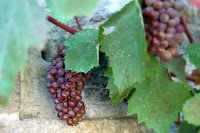Making great wine starts with the vine and the growing of grapevines has its own gardening lore – after all a
 vineyard is just a big garden with one crop. It’s a specialised process but there are techniques and tips that you can follow to grow your own grapevine in the garden here in the UK. Firstly you have to remember that grape vines are only frost hardy which means that they can’t be grown in areas which dip below -5ºC for a significant amount of the winter months. So basically it is hard to grow them above Lancashire but I have heard of vines growing in Scotland!
vineyard is just a big garden with one crop. It’s a specialised process but there are techniques and tips that you can follow to grow your own grapevine in the garden here in the UK. Firstly you have to remember that grape vines are only frost hardy which means that they can’t be grown in areas which dip below -5ºC for a significant amount of the winter months. So basically it is hard to grow them above Lancashire but I have heard of vines growing in Scotland!
There are a multitude of grape varieties to choose from – Sunnybank Vine Nursery  holds
holds
the national collection of grapevines for the UK and they have a mail order catalogue at their website. It is possible to grow the classic Bordeaux varieties – Sauvignon Blanc, Cabernet Sauvignon, Cabernet Franc and Merlot but you can also grow Chardonnay and the Pinots – Auxerrois, Gris, Noir and Blanc. You have to remember that there are 100 days from the point of bud break to the ripening of the grapes and given our dismal weather you need to think about whether your grapes will mature properly in an awful wet British summer. The black grape varieties are the most difficult to grow needing a warmer climate to ripen correctly.
 Grapes have been grown in the UK in centuries past – the Romans grew them and made their own wines here. Grapes were definitely growing in Norman times and wines were made in the monasteries – particularly in the south. The legacy of street names (such as Vine street or the Vineyards) in London and provincial towns and cities – suggests that vines and vineyards were certainly no great rarities. Although the climate may have been warmer then, with the onset of global warming the UK may be a flourishing prospect for vintners once again.
Grapes have been grown in the UK in centuries past – the Romans grew them and made their own wines here. Grapes were definitely growing in Norman times and wines were made in the monasteries – particularly in the south. The legacy of street names (such as Vine street or the Vineyards) in London and provincial towns and cities – suggests that vines and vineyards were certainly no great rarities. Although the climate may have been warmer then, with the onset of global warming the UK may be a flourishing prospect for vintners once again.
To avoid the frost damaging the delicate grape flowers and to get the best
fertilization possible so that they develop into grapes you ought to choose a variety that is late flowering – that way the flowers open into warm, mild weather with plenty of bees and insects around to pollinate them. Grapevines are self fertilising so you don’t need 2 of them to produce grapes. It’s common to grow a grape vine up a south facing wall in the UK where the sun’s rays reflect off the bricks and create a warm micro climate to harbour your vine.
 Ideally you should plant your grapevine when it is dormant and has not broken out into bud so any time from October to March should be all right. However I like to plant them out during April as the ground has warmed up and there are less frosts so that the grapevine doesn’t get a shock. The April showers will naturally water your vine and get it off to a good start.
Ideally you should plant your grapevine when it is dormant and has not broken out into bud so any time from October to March should be all right. However I like to plant them out during April as the ground has warmed up and there are less frosts so that the grapevine doesn’t get a shock. The April showers will naturally water your vine and get it off to a good start.
Grapevines can grow on a wide range of soil types but they do like poor soil, the more gravel the better – but there should be enough nutrients in the subsoil to feed the vine once it has got its roots down. Avoid soils that are persistently wet like clay as grapevines hate getting their feet wet so good drainage is important. The more the grape vine has to struggle then the smaller the yield of grapes and the more concentrated the flavour. Grapevines tolerate a wide pH range. Vines prefer a slightly acidic soil with a pH of 6.0 to 6.5, but grow well with a pH from 5.5 to 7.5.
You will need to cover the surface of the soil around the vine with compost or a layer of stones to help protect the roots from frost. Grape root systems are extensive. The majority of the roots are in the upper 2 to 5 feet of the soil. However, roots can penetrate 25 to 40 feet in coarse, sandy soil!
As for making wine from your grapes – I think that is best left to the experts!
Images Courtesy of www.flickr.com

